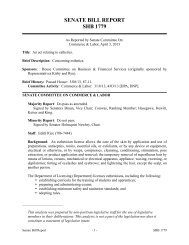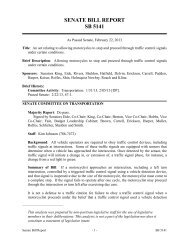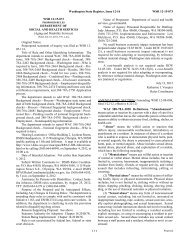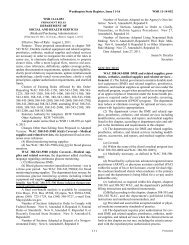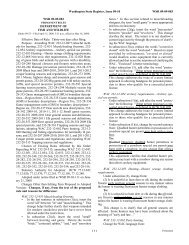Proposed
Proposed
Proposed
You also want an ePaper? Increase the reach of your titles
YUMPU automatically turns print PDFs into web optimized ePapers that Google loves.
WSR 13-02-028 Washington State Register, Issue 13-03<br />
(a) That notification to federal SAMHSA and the department<br />
is made within three weeks of any replacement or other<br />
change in the status of the program, program sponsor, or<br />
medical director.<br />
(b) Treatment is provided to an individual in compliance<br />
with 42 CFR Part 8.<br />
(c) The number of individuals receiving treatment services<br />
does not exceed three hundred fifty unless authorized<br />
by the county in which the program is located.<br />
(d) The individual record system complies with all federal<br />
and state reporting requirements relevant to opioid drugs<br />
approved for use in treatment of opioid addiction.<br />
(e) The death of an individual enrolled in opiate substitution<br />
treatment is reported to the department within one business<br />
day.<br />
NEW SECTION<br />
WAC 388-877B-0405 Opiate substitution treatment<br />
services—Certification requirements. An agency providing<br />
opiate substitution treatment services must be certified by<br />
the department. An agency applying to provide opiate substitution<br />
treatment service must:<br />
(1) Submit to the department documentation that the<br />
agency has communicated with the county legislative authority<br />
and if applicable, the city legislative authority or tribal<br />
legislative authority, in order to secure a location for the new<br />
opiate substitution treatment program that meets county,<br />
tribal or city land use ordinances.<br />
(2) Ensure that a community relations plan developed<br />
and completed in consultation with the county, city, or tribal<br />
legislative authority or their designee, in order to minimize<br />
the impact of the opiate substitution treatment programs upon<br />
the business and residential neighborhoods in which the program<br />
is located. The plan must include:<br />
(a) Documentation of the strategies used to:<br />
(i) Obtain stakeholder input regarding the proposed location;<br />
(ii) Address any concerns identified by stakeholders; and<br />
(iii) Develop an ongoing community relations plan to<br />
address new concerns expressed by stakeholders.<br />
(b) Documentation that transportation systems will provide<br />
reasonable opportunities to persons in need of treatment<br />
to access the services of the program.<br />
(c) A copy of the application for:<br />
(i) A registration certificate from the Washington state<br />
board of pharmacy.<br />
(ii) Licensure to the Federal Drug Enforcement Administration.<br />
(iii) Certification to the Federal CSAT SAMHSA.<br />
(iv) Accreditation by an accreditation body, approved as<br />
an opioid treatment program accreditation body by the Federal<br />
CSAT SAMHSA.<br />
(d) A declaration to limit the number of individual program<br />
participants to three hundred fifty as specified in RCW<br />
70.96A.410 (1)(e).<br />
(e) For new applicants who operate opiate substitution<br />
treatment programs, copies of all survey reports written by<br />
national and/or state certification or substitution programs<br />
within the past six years.<br />
<strong>Proposed</strong> [ 46 ]<br />
(3) Have concurrent approval to provide opiate substitution<br />
treatment by:<br />
(a) The Washington State department of health board of<br />
pharmacy;<br />
(b) The Federal CSAT SAMHSA, as required by 42 CFR<br />
Part 8 for certification as an opioid treatment program; and<br />
(c) The Federal Drug Enforcement Administration.<br />
(4) An agency must ensure that opiate substitution treatment<br />
is provided to an individual in compliance with the<br />
applicable requirements in 42 CFR Part 8 and 21 CFR Part<br />
1301.<br />
(5) The department may deny an application for certification<br />
when:<br />
(a) There is not a demonstrated need in the community<br />
where the applicant proposes to locate the program.<br />
(b) There is sufficient availability, access, and capacity<br />
of other certified programs near the area where the applicant<br />
is proposing to locate the program.<br />
(c) The applicant has not demonstrated in the past, the<br />
capability to provide the appropriate services to assist individuals<br />
using the program to meet goals established by the<br />
legislature.<br />
NEW SECTION<br />
WAC 388-877B-0410 Opiate substitution treatment<br />
services—Agency staff requirements. In addition to meeting<br />
the agency administrative and personnel requirements in<br />
WAC 388-877-0400 through 388-877-0530, an agency providing<br />
opiate substitution treatment services must:<br />
(1) Appoint a program sponsor who is responsible for<br />
notifying the Federal CSAT, SAMHSA, the Federal Drug<br />
Enforcement Administration, the department, and the Washington<br />
State board of pharmacy of any theft or significant loss<br />
of a controlled substance.<br />
(2) Ensure there is an appointed medical director who:<br />
(a) Is licensed by department of health to practice medicine<br />
and practices within their scope of practice.<br />
(b) Is responsible for all medical services performed.<br />
See the program physician responsibilities in WAC 388-<br />
877B-0440.<br />
(c) Ensures all medical services provided are in compliance<br />
with applicable federal, state, and local rules and laws.<br />
(3) Ensure all medical services provided are provided by<br />
an appropriate DOH-credentialed medical provider practicing<br />
within their scope of practice.<br />
(4) Ensure all chemical dependency assessment and<br />
counseling services are provided by a chemical dependency<br />
professional (CDP), or a DOH-credentialed CDP trainee<br />
(CDPT) under the supervision of an approved supervisor.<br />
(5) Ensure there is a designated and identified clinical<br />
supervisor who:<br />
(a) Is a CDP.<br />
(b) Has documented competency in clinical supervision.<br />
(c) Is responsible for monitoring the continued competency<br />
of each CDP in assessment, treatment, continuing care,<br />
transfer, and discharge. This monitoring must include a<br />
semi-annual review of a sample of each CDP's clinical<br />
records.



